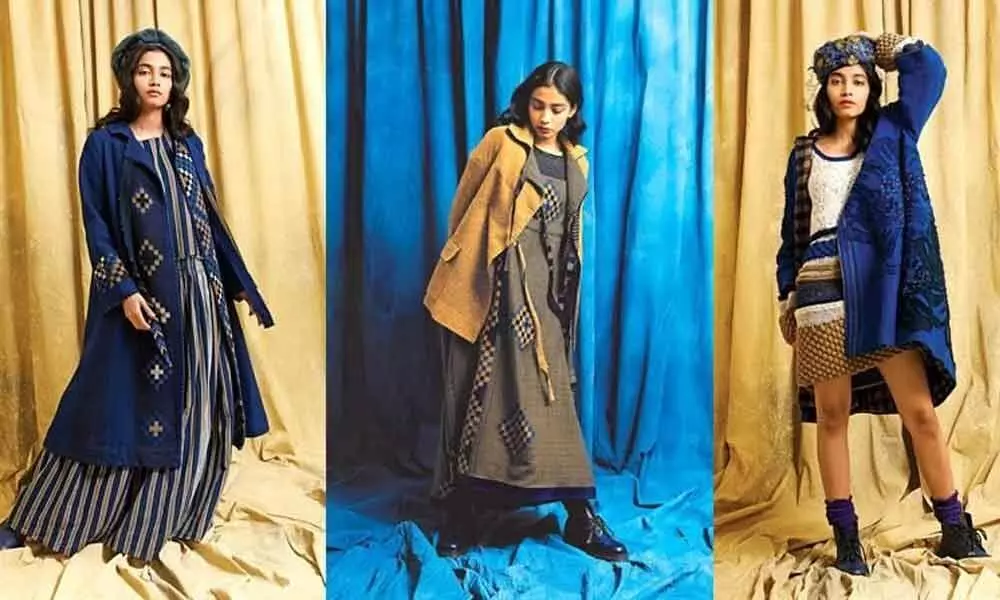Live
- PM Modi greets Minister Pralhad Joshi on his birthday
- Tirupati: Take up repairs of damaged roads, officials told
- Pawan Kalyan meets Vice President Jagdeep Dhankar, Continues Delhi Visit
- Heavy rain alert for Tirupati district due to low pressure
- EPACK Prefab constructs India’s fastest-built structure in 150 hrs
- Woman and her kids die under suspicious circumstances
- BMTC to increase bus running time on each route to drivers and conductors
- PDS implementation in Nalgonda sets a benchmark
- Ph D awarded
- BJP stands strong against Waqf Board misuse
Just In

An exciting collaboration between The Woolmark Company, fashion label Péro and Kullu-based Wool Weavers’ Co-operative, Bhuttico brings Australian wool to Indian looms
Designer Aneeth Arora of Péro does walk the talk as he promotes local artists and artisans with the brand's latest grunge-chic collection.
Tying up with the prestigious 'The Woolmark Company', the designer brand explores the high quality of Australian Merino wool and Himachal Pradesh based co-operative Bhuttico's extra weft weaving technique for the first time in this collection.
Aneeth Arora who is also an alumnus of the prestigious International Woolmark Prize, captures the essence of the ongoing conversation on in blues, khaki and off-white.
Merino wool has long been a fibre of choice for Péro for its natural, renewable and biodegradable qualities. The fibre's durability, versatility and trans-seasonality makes it a right choice for India's varied climate.
Moving into the picturesque town of Kullu in Himachal Pradesh, Péro was inspired by the work of the artisans and this helped to visualise the revival of traditional geometric patterns of "Pattu" in monochrome colours.
The collection also used recycled water repellent tarpaulin with special handwoven Kushi Kullu tapes, transforming the garments into more functional, flexible pieces.
This marks the final journey of Merino wool from Australia to the #madeinIndia loom and onto the fashion runways. Aneeth Arora talks out more.
How was it to associate with Bhuttico?
We have been working with the Kullu weavers for the past ten years, but we have never experimented with the traditional weaves of Kullu.
When we got the opportunity to work with Bhuttico, we realised their strength was weaving the traditional textiles of Himachal Pradesh.
And we were very excited to work with it because Pero has a philosophy of working with traditional craftsmen. So I would say it was a very good opportunity to work with the tradition with the experts who can do it the best.
And the fact that The Woolmark Company was with us on this, we could work on the traditional craft in the purest form of wool. So it was a good mix of The Woolmark Company and Bhuttico, and two pure traditions coming together.
What was the core idea behind designing the collection with Merino wool?
It is not that because The Woolmark Company came on board, so we worked with Merino. We have been working with Australian Merino for the past nine years.
The advantage of having Woolmark on this with us was that we got a lot of help in terms of solving quality issues, and solving other issues which when we were independently working with Australian Merino we couldn't do, so we had inputs from their technical team.
We also learned a lot about the source of wool. I think that it enhanced our learning of Merino, that we have had for years because working directly with the source has helped us do it better this time.
What challenges did you face working with Merino wool?
I think there were no challenges because the fiber is so versatile that one can just experiment with it in the yarn stage or blend it with other fibres like linen and silk.
The fact that one could weave the lightest possible wool and the heaviest wool, we didn't face any problems per say working with wool.
What is unique about this collection?
I think the best part about the whole collaboration was coming of The Woolmark Company and Bhuttico and Pero together because we worked with everybody's strengths where we got the best of Australian Merino, we got the best of craftspeople from Bhuttico who specialize in traditional weaving, and then there was Pero that always wants to work with traditional crafts of India.
So I think that it was the sum of all three entities involved which made this collaboration very special.
The 'Grown in Australia, Made in India' handmade textiles and garments signify the importance of craft, culture and heritage in today's fashion industry.
The collection will be available across 250 to 300 stores across 35 countries.

© 2024 Hyderabad Media House Limited/The Hans India. All rights reserved. Powered by hocalwire.com







